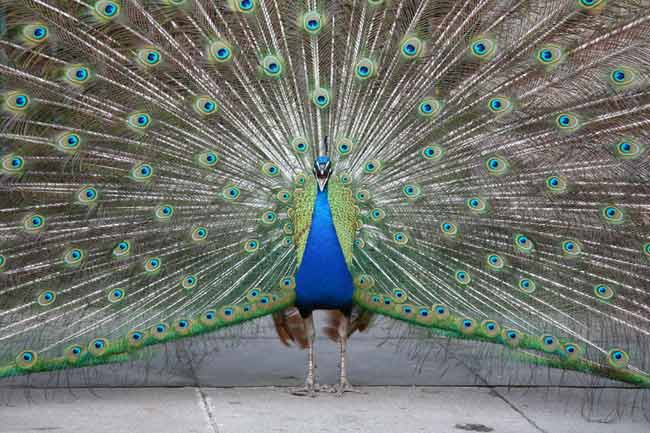Despite Flash, Males are Simple Creatures

The secret to why male organisms evolve faster than their female counterparts comes down to this: Males are simple creatures.
In nearly all species, males seem to ramp up glitzier garbs, more graceful dance moves and more melodic warbles in a never-ending vie to woo the best mates. Called sexual selection, the result is typically a showy male and a plain-Jane female. Evolution speeds along in the males compared to females.
The idea that males evolve more quickly than females has been around since 19th century biologist Charles Darwin observed the majesty of a peacock’s tail feather in comparison with those of the drab peahen.
How and why males exist in evolutionary overdrive despite carrying essentially the same genes as females has long puzzled scientists.
New research on fruit flies, detailed online last week in the journal Proceedings of the National Academy of Sciences, finds males have fewer genetic obstacles to prevent them from responding quickly to selection pressures in their environments.
"It’s because males are simpler," said lead author Marta Wayne, a zoologist at the University of Florida in Gainesville. "The mode of inheritance in males involves simpler genetic architecture that does not include as many interactions between genes as could be involved in female inheritance."
The finding could also shed light on why diseases show up differently in men and women.
Get the world’s most fascinating discoveries delivered straight to your inbox.
Complicated chromosomes
Wayne and her colleagues examined more than 8,500 genes shared by both sexes of the fruit fly Drosophila melanogaster. Of those genes, about 7,600 have different expressions (alleles) that do different jobs in males and females.
The flies were identical genetically, except for their sex chromosomes.
In flies and humans, thousands of genes made up of DNA are packaged into tiny units called chromosomes. Each parent contributes one set of 23 chromosomes to offspring, resulting in little ones with 23 father-given chromosomes and 23 mother-chromosomes—46 total. One pair of these is called the sex chromosome. In this case, the females have two X chromosomes (XX) and males, XY.
Many genes are found on the X chromosome, whereas few are associated with the Y chromosome. For female fruit flies, the X-chromosome genes can come in two flavors called alleles that not only interact with each other but also with other genes.
For instance, if one allele is dominant over the other, that allele would get "expressed" while the recessive allele would stay hidden. Though under cover, the recessive allele kind of hitches a ride on the X chromosome and can be passed on to future generations.
Genetic simpletons
That's not the case with males.
"We find direct evidence that the expression of the genes on the X has this covering behavior in females whereas in males they're out in the open," said study team member Lauren McIntyre, also of UF.
Males only have one X chromosome, so what you see is what you get. If that particular gene gives the male a boost in terms of sexual selection, say a gene responsible for fluffier feathers, the gene would be selected for in the game of natural selection over successive generations. But if the gene is no good for males, it would get selected against over time.
"Having one X means your genes are more open to selection in males," UF researcher Marina Telonis-Scott said in a telephone interview. "So in a female if you have a recessive allele that confers a sickness, it can be concealed within the two X's but if you've only got one, such as the male, you're more open to selection."
And the reason males are genetic simpletons, it turns out, is sex. The researchers suggest this uncomplicated (compared with females) genetic pathway allows males to respond at the drop of a hat to the pressures of sexual selection. That way they can win females, produce more offspring and start the cycle over again.
While not as prominent a trend, they also found a similar pattern in so-called autosomal genes, which are those found on any chromosome save the sex chromosomes. Many of the fruit-fly autosomal genes, however, did work in concert with genes located on the X chromosome.
Human implications
The "elephant lurking in these results," of course, is how they would apply to men and women.
The researchers caution the results don't directly translate to humans. "The X function is thought to be quite different in flies than humans," McIntyre told LiveScience. In humans, one of the X chromosomes gets inactivated in females, though research is finding this inactivation isn't always absolute.
However, the results could help explain differences in symptoms and responses to diseases in men and women, the authors say. Sexual selection does occur in humans, they note. In addition, fruit flies and humans share an evolutionary history, the authors point out, which is the reason why we share more than 65 percent of our genes with the tiny insects.
"If we see a mechanism in flies it may also be true in everything that shares that evolutionary history," McIntyre said.
On a basic level, the genetic machinery works in a similar manner in flies and us.
"There's a health aspect in figuring out differences in gene expression between the sexes," Wayne said. "To make a male or a female, even in a fly, it's all about turning things on—either in different places or different amounts or at different times—because we all basically have the same starting set of genes."
- Mating Game: The Really Wild Animal Kingdom
- 10 Things You Didn't Know About You
- The Sex Quiz: Myths, Taboos and Bizarre Facts
Jeanna Bryner is managing editor of Scientific American. Previously she was editor in chief of Live Science and, prior to that, an editor at Scholastic's Science World magazine. Bryner has an English degree from Salisbury University, a master's degree in biogeochemistry and environmental sciences from the University of Maryland and a graduate science journalism degree from New York University. She has worked as a biologist in Florida, where she monitored wetlands and did field surveys for endangered species, including the gorgeous Florida Scrub Jay. She also received an ocean sciences journalism fellowship from the Woods Hole Oceanographic Institution. She is a firm believer that science is for everyone and that just about everything can be viewed through the lens of science.


